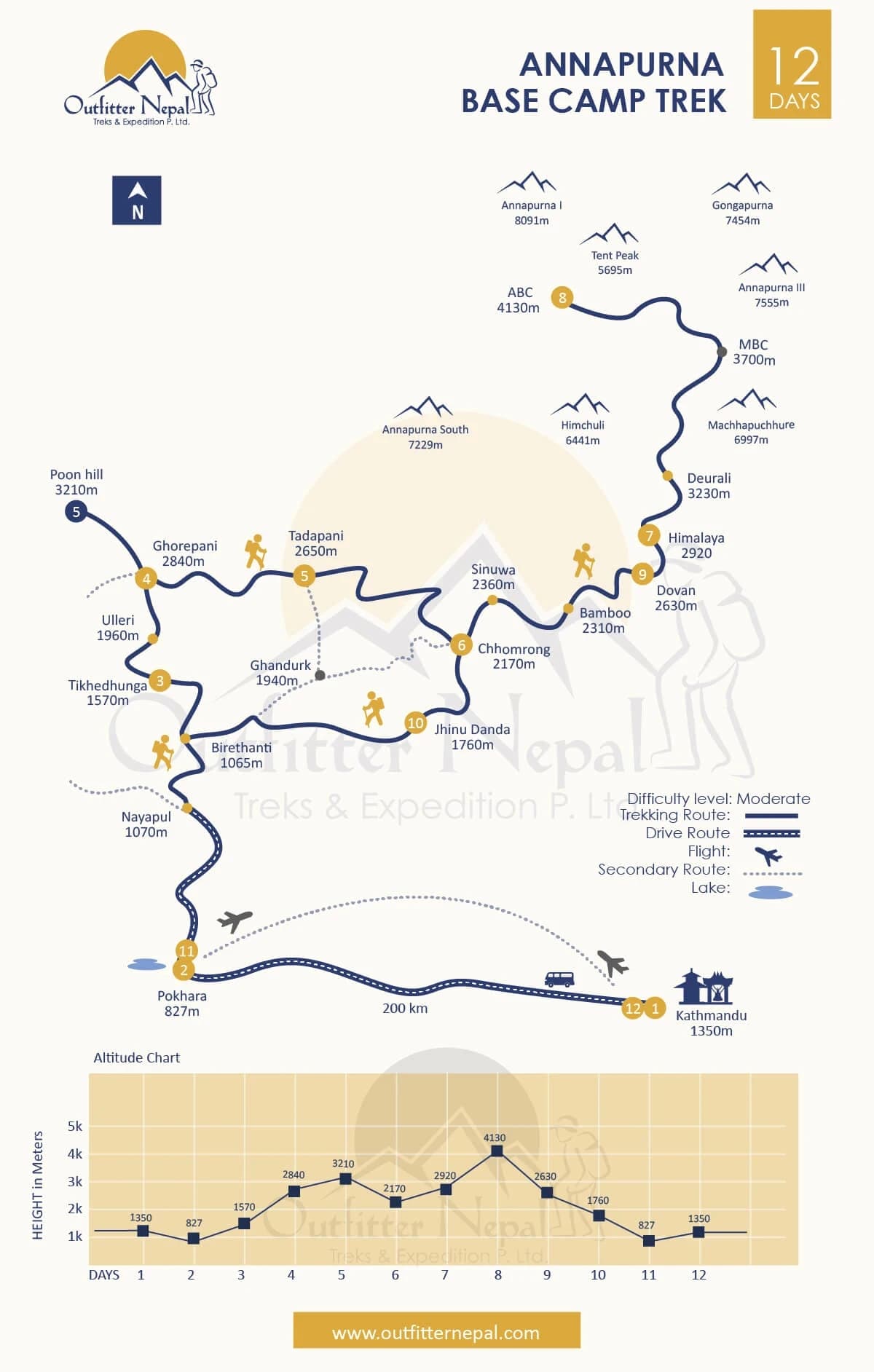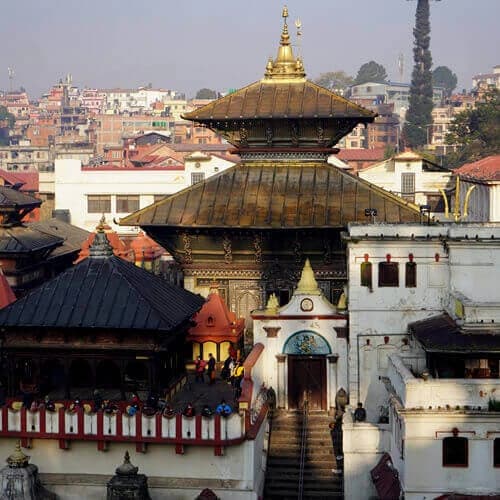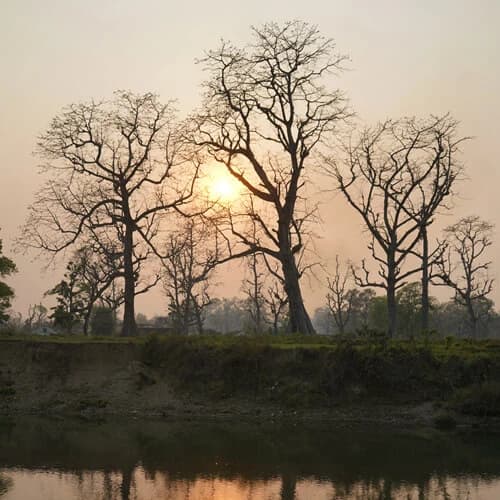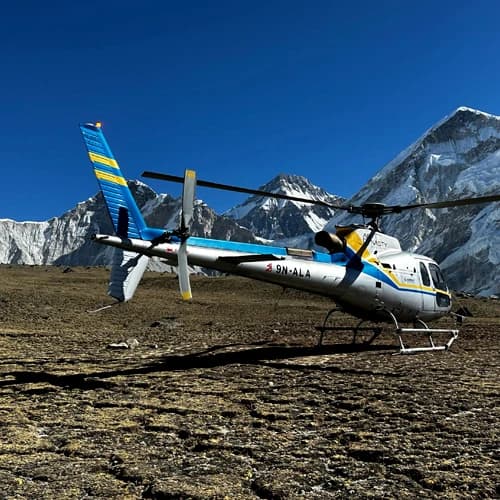Highlights of the Annapurna Base Camp Trek
- A perfect itinerary for travelers who are looking for a moderate trek adventure in just under two weeks in the Himalayas of Nepal.
- Hike on well-trodden and marked routes suitable for both seasoned and beginner trekkers.
- Walk through bamboo, lush rhododendron, and varied landscapes transitioning from farmlands, hills, to rugged, alpine terrain.
- Reach the heart of the Annapurna Sanctuary, an amphitheater surrounded by towering peaks like Annapurna I, Hiunchuli, and Gangapurna.
- Stay at teahouses and lodges, and experience the rich culture, way of life, and hospitality by interacting with the native communities, including Gurung, Magar, and Thakali.
- Hike to Poon Hill and witness a breathtaking sunrise from the viewpoint, as the sunrays illuminate the majestic Annapurna I, Dhaulagiri, and Machhapuchhre (Fishtail) peaks.
- Experience a sense of achievement at the base camp of Mount Annapurna, the world's tenth-highest peak.
- Relax and soothe your muscles in the therapeutic natural hot springs at Jhinu Danda.
- Conclude your adventure at Pokhara, the serene “city of lakes”, and spend your remaining time at a local cafe, bar, and coffee shop.
Overview of the Classical Annapurna Base Camp Trek 13 Days
The Annapurna Base Camp Trek is a breathtaking adventure in the western Himalayas of Nepal, offering stunning views of some of the world's highest mountain peaks. Also known as the "Annapurna Sanctuary Trek", the journey passes through the Annapurna Conservation Area, Nepal's first and largest conservation project, established in 1986.
You will hike through dense pine, oak, and rhododendron forests, with close encounters with birds and wildlife, including Himalayan tahr, blue sheep, and langur monkeys. Following the footsteps of Maurice Herzog, who made the first successful ascent of Annapurna I, our adventurous journey takes us through varied terrains.
It is a perfect opportunity for you to explore the lesser-explored corners of the Annapurna region. Along the way, you will stop by cultural villages like Ulleri, Ghorepani, and Tadapani. Spending the night at the teahouses in these key locations provides an introduction to the unique culture and lifestyle of different ethnic groups, including the Gurung, Magar, and Thakali.
The Classic Annapurna Base Camp Trek route primarily follows the ancient trade route, which is adorned with Buddhist heritage sites, monuments, mani walls, chortens, prayer flags, and monasteries. Additionally, you will encounter several swinging bridges to cross the river, providing an unforgettable, adrenaline-pumping experience. The Kadoorie swinging bridge is the region's longest bridge.
Embarking on the remarkable trek takes you to Poon Hill, where you can witness the incredible sunrise and the stunning Annapurna Base Camp. From these incredible vantage points, travelers witness spectacular views of Annapurna South (7,219 m), Hiunchuli (6,441 m), Machhapuchhre/Fishtail (6,993 m), Annapurna I (8,091 m), Annapurna III (7,555 m), Gangapurna (7,455 m), and Dhaulagiri (8,167 m).
Join our team of experienced guides and support staff on the Annapurna base camp trek 2026/2027 departures and enjoy a hassle-free journey. With over 15 years of experience, Outfitter Nepal offers firsthand knowledge to every expedition, ensuring you are in expert hands from start to finish. Our professional, government-licensed guides are proficient in English and have undergone extensive training for high-altitude operations.
They will assist you throughout the journey and ensure your safety and well-being. With a ratio of one guide for every 4-5 trekkers, they are equipped with a first-aid kit and are always on hand to offer guidance on proper hydration and pace. Additionally, our affiliation with the Nepal Mountaineering Association (NMA) and the Trekking Agencies' Association of Nepal (TAAN) serves as a testament to the fact that our tours and treks adhere to national standards of safety and quality.
A Typical Days on Annapurna Base Camp Trek 13 Days Itinerary
The 13 Days Classical Annapurna Base Camp Trek is an immersive Himalayan journey that challenges your physical and mental endurance while rewarding you with unparalleled natural and cultural beauty. The trek gradually unfolds from the streets of Kathmandu to the quiet mountain villages of the Annapurna region. A typical day on the trail involves hiking for 6 to 8 hours, covering an approximate distance of 10 to 12 kilometers. You will navigate a wide variety of terrains, from terrace fields and lush valleys to rugged paths and steep stone steps.
The trek is considered moderately challenging, but it is achievable for individuals with good physical fitness and mental resilience. To prepare yourself, it is suggested to build your leg strength, stamina, and cardiovascular health, as the daily hikes are demanding. Additionally, as you ascend to higher elevations, the air becomes thin with low levels of oxygen, increasing the risk of altitude sickness above 3,000 meters. To prevent it from happening, we have designed our itinerary with strategic stops and a gradual ascent for acclimatization. This helps your body adapt to atmospheric changes, avoiding overexhaustion and fatigue.
from the physical effort, each day during the Annapurna Base Camp Trek is packed with major highlights. This includes cultural immersion in traditional Gurung villages, witnessing stunning sunrises from Poon Hill, experiencing spiritual awakening at monasteries, and taking in breathtaking views of Annapurna and Machhapuchhre (Fishtail). After reaching the Annapurna base camp, the descent is relatively easy, and you will have the opportunity to relax your tired muscles in the natural hot springs at Jhinu Danda. Besides, to make the most of this trek, we recommend trekking during the spring (March, April, May) and autumn (September, October, November), when the weather and trail conditions are optimal.
Why Classic Annapurna Base Camp Trek with Outfitter Nepal?
Choosing Outfitter Nepal for your next big adventure means entrusting your safety and well-being to people who know the Himalayas and have extensive experience navigating the routes. Our team has the utmost confidence in their ability to deliver an authentic, memorable, and safe travel experience to you.
They are more than just a guide; they are native to the region, with over a decade of experience and a personal connection to the trail and the communities along the route. Our staff members are licensed personnel certified by the Government of Nepal, possessing comprehensive first-aid knowledge and prepared for any emergency, including helicopter evacuations.
Moreover, we offer personalized itineraries that provide an acclimatization and buffer days, so you can trek at a pace that is comfortable for you. We are dedicated to giving you a no-stress, all-inclusive experience, we take care of everything, from permits to government paperwork. Our pricing is fair and transparent, with no hidden cost! The Annapurna Base Camp Trek Cost is 1089 USD per person and can reach 927 USD per person based on the group size of 2-6 person. The price of the package also depends on the itinerary, services, and the group size.
Furthermore, apart from being pioneers in the trekking industry, we are committed to eco-friendly practices and sustainable tourism. Outfitter Nepal is also dedicated to supporting local communities and ensuring fair wages for our staff and porters. Each of our treks follows the Leave No Trace initiative to minimize our impact on the environment, serving as a testament to the responsible nature of your adventure.





